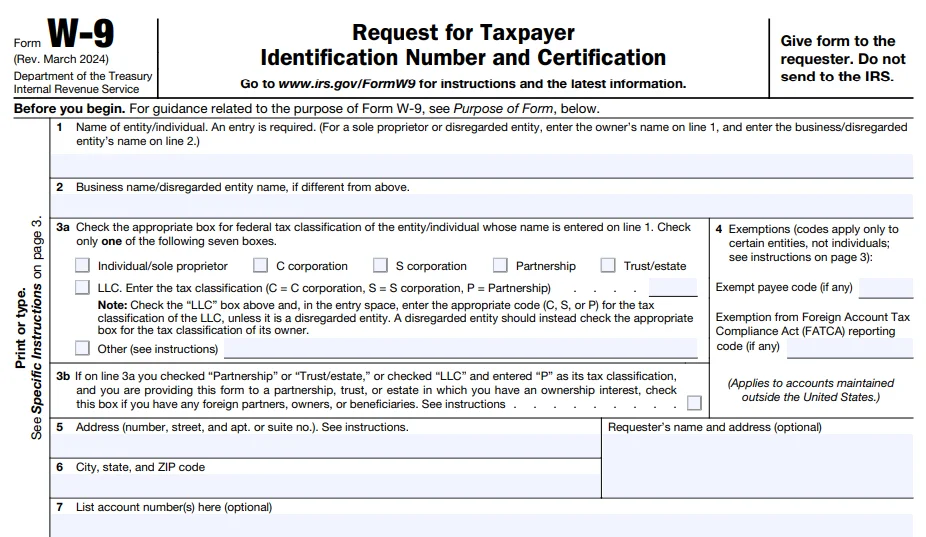W-9 for Corporations - An Overview
Updated on January 22, 2025 - 10:30 AM by Admin, TaxBandits
Tax forms may often feel like a maze, and the W-9 form is one that corporations and independent contractors frequently need clarification on. Though it may seem challenging, this document is a vital conduit between corporations and contractors. In this article, we'll break down Form W-9, explaining what it is, what information it requests, and how corporations manage it.
Table of Contents:
1. What is Form W9 for Corporations?
A W9 Form, also known as the "Request for Taxpayer Identification Number, is an IRS document that sends a person's Tax Identification Number (TIN) to their payer (or whoever is responsible for submitting a 1099 with the IRS).
2. What is the Purpose of Form W-9 for Corporations?
The W-9 form is more than just a piece of paper; it's an important tool that helps corporations get vital data from people and organizations that offer services. Essentially, the form aims to get the service provider's taxpayer identification Number (TIN) so corporations can appropriately record income payments to the IRS. The corporation may use a Form W-9 for two different reasons:
- If the corporation has employed independent contractors or freelancers for any contractual work, they will need to collect their tax information through Form W-9 as it is needed to file the 1099 form.
- On the other hand, when the corporation renders contractual work to a third-party entity or an individual, it will be asked to fill out Form W-9 to provide its required tax information.

Note: If you are a payee, you can directly complete and share your W9s with your payers. Click here to learn more information about Fillable W-9.
3. How do corporations fill out Form W-9?
For corporations doing business with suppliers or service providers, completing the W-9 form is a routine protocol. Here’s how corporations can fill out Form W-9:
-
Name (Lines 1 and 2):
On line 1, enter the corporation's name as it appears on the entity's tax return. On line 2, enter the trade or DBA name, if any.
-
Federal Tax Classification (Line 3):
Line 3 requires corporations to declare their federal tax classification.
- The Corporations can check either ‘S-Corporation’ or ‘C-Corporation’ based on their classification.
- The LLCs that have filed Form 8832 or 2553 to be taxed as a corporation can check the box for Limited Liability Company and enter the appropriate tax classification. ( C= C corporation; or S= S corporation). To learn more about this, click here.

C Corporation (C Corp):
The standard corporate structure is a C corporation. It is a distinct legal entity and must pay federal income tax on its earnings. Every dividend a C Corporation's shareholders receive is subject to individual taxation. Since the corporation and the shareholders pay individual and corporate taxes on the same revenue, this is sometimes called "double taxation."
S Corporation (S Corp):
An S Corporation chooses to distribute its corporate income, losses, deductions, and credits to its shareholders for federal tax purposes. This indicates that the corporation typically does not pay federal income tax. Instead, the shareholders report the corporation's revenue on their tax filings.
-
Exemptions (Line 4)
This line describes if the corporation is exempt from Backup withholding and FATCA reporting.
-
Exemption from Backup withholding reporting.
If the corporation is exempt from Backup withholding, enter the applicable code(s) in the corresponding field on line 4. The appropriate code for the corporation is 5. Corporations are exempt from backup withholding for certain payments, including interest and dividends.
-

- Payments made in settling payment cards or third-party network transactions are not exempt from backup withholding for corporations.
- Also, Corporations are not exempt from backup withholding on fees or gross revenues paid to attorneys, and corporations that offer medical or health care services are not exempt from Form 1099-MISC payments.
-
Exemption from FATCA reporting.
If the corporation is exempt from FATCA reporting, enter the applicable code(s) in the corresponding field on line 4 based on the business size. The appropriate codes for the corporation are D and E.
-
Address (Lines 5 and 6):
Enter the corporate address, which includes the building number, street, unit or apartment number, city, state, and zip code.
-
Account Number (Line 7):
This is an optional field. List the corporation’s account number if required.
-
Taxpayer Identification Number (Part I):
Enter the TIN of the corporation. The responsible party's Employer Identification Number (EIN) or, in some situations, Social Security Number (SSN) may be this. For tax reasons, the TIN acts as a unique identification.
-
Certification (Part II):
The last part of the Form W-9 is certification, which requires the corporation to acknowledge certain things:
- Provide the correct Taxpayer Information Number(TIN)
- They are not subject to backup withholding
- They are a U.S. citizen
- The FATCA code(s) entered on this form to indicate that they are exempt from FATCA reporting is correct.
Once reviewed, sign the IRS Form W-9 and ensure accurate information.
4.How do corporations complete Form W-9 with TaxBandits?
For corporations to maintain regulatory compliance and seamless financial transactions, completing Form W-9 is a vital responsibility. By using TaxBandits' features, corporations may expedite the submission of Form W-9, thus saving time and providing precision in their tax-related operations.
- TaxBandits' fillable W-9 solution is to streamline the process for corporations to fill out and send a W-9 to their payers.
- Conversely, corporations requesting and collecting W-9 Forms from their independent contractors can use TaxBandits Form W-9 Manager.
